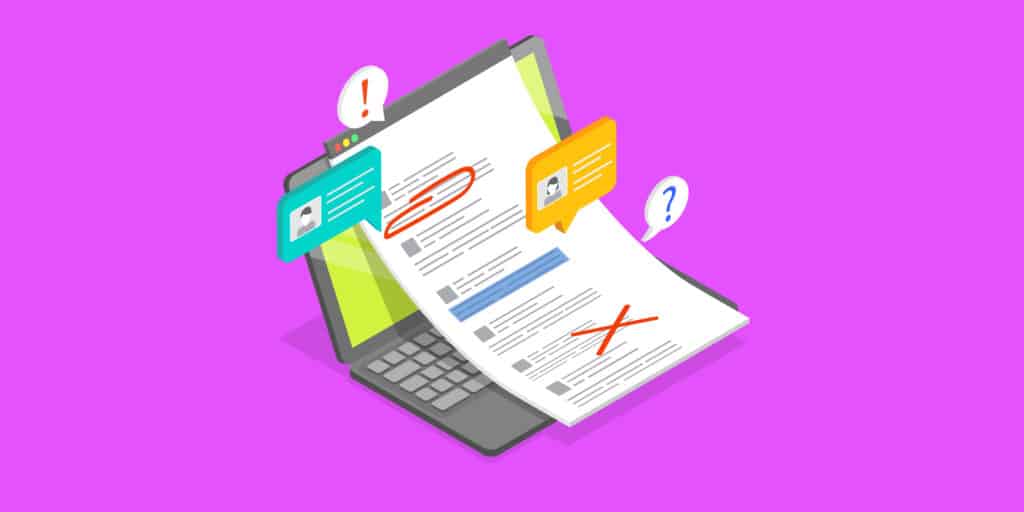Raise your hand if you’ve ever poured your heart into writing a proposal—only to find a glaring typo after you submitted it. 🙋
It’s a tale as old as time. When the stakes are high (and time is scarce), four notorious “proposal monsters” emerge from the shadows, ready to wreak havoc on your work and cause avoidable mistakes.

Proposal Monster #1: The Jargon Monster
This monster insists you include every single technical detail about your product or service. They are long-winded and short-sighted, stifling your message with unnecessary complexity.

Proposal Monster #2: The Old Fuddy-Duddy
This monster echoes words of the past, “Back in my day, we did everything in Word. We should stick with what works.” They don’t realize the importance of design in modern proposals.

Proposal Monster #3: The Three-Headed Beast
When it comes to editing, this monster is stuck in the loop of three limiting beliefs: “There’s not enough money.” “There are not enough resources.” or “There’s not enough time to do it right.”

Proposal Monster #4: The Boilerplate Blob
This monster will not waver from its deviated path. It seeks to maintain rigid standards and refuses any alterations or personalized requests to its carefully crafted proposal.
Any or all of these proposal monsters can derail the success of a proposal. But, according to Samantha Enslen of Dragonfly Editorial, they can also be vanquished. ⚔️
In this article, you’ll learn how to slay proposal monsters once and for all—and avoid these common mistakes in proposal writing
1. Too Many Words: Overcome the Dreaded Wall of Text
When you put so much work into crafting a compelling proposal cover letter, the last thing you want is the evaluator to overlook it because of an overwhelming volume of text.
Put yourself in their shoes: You eagerly open a proposal but immediately see never-ending paragraphs, run-on sentences, and zero white space. Does that seem inviting to read? Hardly—it just becomes a daunting task (and a throbbing headache in the making).
“Evaluators want to read quickly, score easily, and go home early. Are you extending this courtesy to them in your proposals?”

So, how do you make your proposals more appealing to read? Remember Schramm’s Fraction of Selection Formula:
Expectation of reward / perception of effort = likelihood of activity
In other words, the reward for the evaluator is being able to read your proposal quickly, score easily, and go home early. But if there’s a high perception of effort, they’re going to have low enthusiasm about reading your proposal (and might not even read it all the way through).
On the other hand, their enthusiasm for reading your proposal will be higher if the perceived effort is lower. “When you break up content into digestible chunks, there’s more room for the evaluator’s eyes to relax,” says Samantha. “All of a sudden, you’ve switched up the equation.”
⚔️ How to Conquer This Common Mistake in Proposal Writing
✓ Choose simpler, shorter words: Think “help” instead of “facilitate,” “use” over “utilize,” or “now” instead of “immediately.”
✓ Simplify phrases: When you have to use technical jargon, make sure the phrases surrounding it are short and sweet, like “can” instead of “has the capability to.”
✓ Write shorter sentences: Studies from the American Press Institute show that sentences with fewer than 14 words have a comprehension rate of 90%.
✓ Write shorter paragraphs: Evaluators will skim a paragraph that’s too long. Don’t be afraid of the [Enter] button on your keyboard and consider using bullet points to highlight key takeaways (like we did here).
✓ Aim for an 8th grade reading level: Even highly educated readers crave information that’s clear and concise. So, skip the Shakespeare monologues and pass your proposal through a readability tool like the Hemingway App.
2. Too Little Design: Transform a Boring White Piece of Paper
Another common mistake in proposal writing is failing to add any design elements. It’s one thing to improve readability and another to direct the evaluator’s attention to key information.
In other words, you can use the structure of a proposal to communicate your message in a professional-looking yet fun and engaging way. Some examples include:
- Adding an eye-catching stock photo to your cover
- Playing with geometric shapes to house content
- Using a bold sans serif font for your headings
- Highlighting key features with industry-relevant icons
- Using ribbons or arrows to point to specific information
- Including customer headshots in your testimonials
Of course, some requests from proposals (RFPs) come with strict formatting guidelines, like font size or minimum margin requirements. In that case, you must work within your given constraints, which might mean you have to lean a little more on the proposal writing tips above.
However, if you have the freedom to design a proposal head to toe, think strategically (and creatively) about how to transform your text. “Imagine what you can do with a little colour,” says Samantha. “You can help evaluators understand your proposals—and remember them.”
⚔️ How to Conquer This Common Mistake in Proposal Writing
✓ Make your headings do the heavy lifting: Using descriptive headings can ease navigation and create anticipation. Think of them as signposts that help the evaluator find the information they’re most excited to read.
✓ Add a splash of your colour palette: Brand colours have a psychological impact on customers—yellow represents optimism, blue means trust. By adding your brand colours to the proposal, you show the evaluator who you are as a company.
✓ Use eye-catching graphics: According to this study, graphics improve reading comprehension by 40%. Whether you use a pie chart or infographic, you can help the evaluator form mental bookmarks and remember important stats and figures.
3. Skipping the Edit: Fix Grammar and Spelling Mistakes
Remember the three-headed beast? This monster tends to rear its head in the final hours of writing a proposal. You might hear excuses like: “There’s no time to edit.” “We don’t have the people.” “If we outsource editing, it’s going to cost money. And we don’t have that either.”
But crossing your fingers isn’t a reliable plan B—it only takes one typo to ruin your chance of winning. When competition is already so high, the last thing you want is to lose the bid because you wrote “we are defecated to your success” when you meant to write “dedicated.” Oops! 🙈
For more proof, this dissertation by Randall J. Hicks showed that misspellings and grammar mistakes negatively impact a person’s willingness to fulfill requests. Isn’t that precisely what you’re asking evaluators to do?
You’re requesting them to choose your services. Typos make them less likely to say “yes.”
In other words, these slip-ups give off the impression you don’t pay attention to detail, casting doubts on your credibility and professionalism, and eroding trust in your company.
Of course, editing a proposal takes time, but it’s time well spent. “The solution here is simple: carve out time for editing and make it a priority,” says Samantha.
⚔️ How to Conquer This Common Mistake in Proposal Writing
✓ Give yourself a full day away from the proposal: This helps you return to the document with fresh eyes and an objective view of your writing.
✓ Change the document font: This can trick your brain into seeing the text as a new piece of writing, helping to uncover once overlooked misspellings.
✓ Read the proposal out loud: If your proposal doesn’t sound right, it might mean your sentences are too long and complicated, or your point isn’t coming across clearly.
✓ Proofread one last time before submission: During your first round of edits, you might restructure sentences and make a new grammar mistake. So, proofread one more time (and then once more) just to be sure.
✓ Pass the proposal through an editing app: Tools like Grammarly or ProWritingAid can automatically catch spelling errors and help make your content more readable.
✓ Stick to a content style guide: Not sure how to properly use the oxford comma or if subheadings need to be title case? Ask your marketing team for a content style guide.
4. Ignoring the Customer: Go Beyond a Boilerplate Proposal
This final proposal writing mistake is the most important to avoid: Not taking the time to truly customize the proposal for a particular customer.
In the race against the clock, it’s a great idea to use generic templates or automatically fill in RFP answers through proposal management software. But this should only be your starting point…
That’s because a cookie-cutter approach leaves customers feeling unimportant (and unimpressed). In comparison, tailoring the proposal to their specific challenges and needs shows you value their business and are genuinely interested in solving their problems.
“Approach every proposal as a chance to tell a story. Who is your customer? What problems are they trying to solve? How can you help them?”

For example, let’s say your association management program is number one in the market. While this fact may be true, it fails to explain why it matters to the customer. Instead, frame this information as a benefit, like how activating your program will boost their membership numbers.
“When the customer feels like, oh, they actually get me—that’s the moment you’ve won the sale,” says Samantha.
⚔️ How to Conquer This Common Mistake in Proposal Writing
✓ Start with the basics: Ask yourself—who is the customer, what do they do, what problem are they facing, and why are they trying to solve this problem right now?
✓ Gather more intelligence: Work with your sales team to understand the competitive landscape. Ask them––Has the customer tried other solutions? Why hasn’t it worked?
✓ Paint a best-case scenario: If you won the contract, what would life look like for the customer? How can you communicate this utopia outcome in the proposal?
✓ Go beyond the features: Identify which features will help the customer most, then describe why each feature really matters to them.
✓ Back up your story: Have you completed projects like this before? Talk to your operations staff (or relevant SMEs) to find out why you were successful.
✓ Flip the script: Speak directly to your customer—put the focus on them by replacing every “we” with “you.” This trick makes them feel acknowledged and valued.
P.S. Check out this resoorce on how to write a bid proposal to ensure your customers stay top of mind while writing. 💡
Win the Proposal Writing Battle, Win the Contract
Coming face to face with proposal monsters can be daunting, but fear not. When you write concisely, unleash your creativity, edit thoroughly, and prioritize customization, you can avoid the common mistakes in proposal writing.
So, take a deep breath and banish those monsters from your mind. You have all the tools you need to defeat them, confidently follow the steps in proposal writing, and make the shortlist.
Want to learn more about proposal writing? Learn how to create a repeatable RFP response template (PDF sample).
